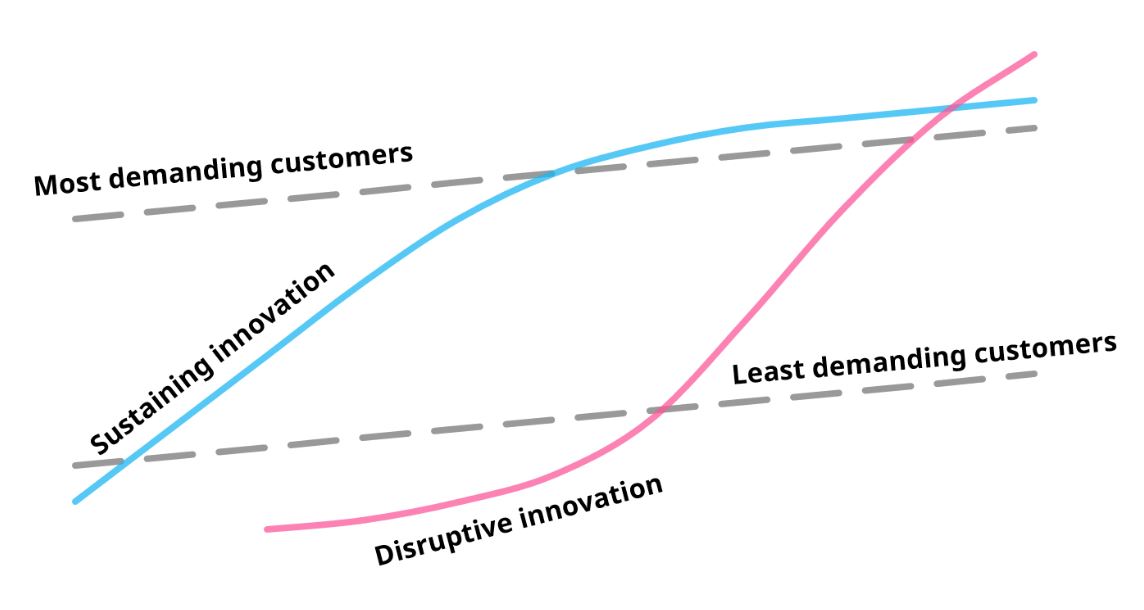World’s changing and you know it. Changing so rapidly, that yesterday's wonders seem commonplace to us today. Not so long ago, people only dreamed of remote communication, and today we are already picking up a smartphone with 5G support.
Innovation is what drives our world forward. And disruptive innovation is what irreparably changes it.
What is disruptive innovation?
There are 4 types of innovations:
-
radical innovation
All that didn’t exist before and what created a new branch of the market. If you came up with a new product, let's say like a plumbus from Rick and Morty, and its presence would entail a transformation of the market - this is a radical innovation. In the ordinary world, after this, you would become a monopolist in the plumbus market, but only after you spent huge amounts of money on its development.
-
supportive innovation
These innovations are usually introduced by large companies to keep their product competitive and to stay on the market. That is, to maintain the demand for your product even after competitor innovations. For example, camera modules in smartphones, where over time appears more and more lenses.
-
incremental innovation
It means improving the existing product in order to increase its sales. Most often, it is the work of marketers who study the needs of the target audience. For example, a Heinz bottle that we put on the lid or Instagram stories.
-
disruptive innovation.
And here they are. This is a combination of innovative technologies with new business models, so for such an innovation to exist you’ll need new developments. Let's talk about what disruptive innovation is in more detail.
The term “disruptive innovation” was first used in 1995 by Clayton Christensen in the article “Disruptive Innovation: Catching the Wave,” which he co-wrote with Joseph Bower. Their essence lies in changing values in the market. After disruptive technology becomes part of the mainstream, all existing products on the market cease to be competitive. They lose their advantage because the parameters that previously determined market leadership are no longer relevant.
Disruptive innovations start at the very bottom of the market, after which they begin to develop rapidly, crowding out those who were at the top. Heard about the Fortune 500? The annual list of the world's richest corporations is constantly changing precisely because of the “disruptors”.
This prevents large companies from relaxing and the world is changing because innovators are finding the best alternative to familiar products. If it were not for such innovations, the world would never have moved forward. No one would have come up with Wikipedia, Facebook or, if you go back to antiquity, a wheel. But no matter how ingenious an innovation is, everyone, not just historical figures, is capable of doing it. Because even historical figures began with the fact that they were mediocre.
How to identify a disruptive innovation?
-
They are easily accessible. Any disruptive innovation at first was just a small idea for something big. Remember the first computers? They were expensive and no one used them until the available options appeared on the market to put them on your desk.
-
They are slow. Do you remember the moment when everyone SUDDENLY started using Facebook? Probably not. Most likely, you remember how some acquaintances told you about this social network, and at first you didn’t care. But the more acquaintances there were, the less indifferent you became.
-
They are introduced by previously unknown companies. Experienced companies simply do not see the point in such a strategy, more profitable for them is to turn to supportive or incremental innovations.
-
They are unobtrusive.
Most often, the popularity of disruptive innovations is provided not by an advertising strategy, but by the fact that the product is really more convenient than its predecessors.
Disruptive innovation is a step forward in meeting the needs of the market because they create a technology that is simpler and better than the previous one. Humanity will not take this step synchronously, therefore disruptive innovations are often underestimated, but nevertheless they take us to a new hight.
How disruptive innovations are changing the market?
When disruptive innovation first hits the market, more often than not, it goes unnoticed. No matter how good a product is, the market will not trust it immediately.
At first, disruptive innovations weren't used by the largest and most profitable market segment.
But everything changes when disruptive innovation enters the mainstream. The more consumers start using it, the faster its popularity begins to grow, because if this product is simpler and better than the previous one, people will want it more. People are lazy and love simple stuff.
Disruptive innovations enter the market slowly, but their effects are almost instant.
According to the disruptive innovation business model, it first targets an audience for whom product availability is more important than quality. Its path begins either with the “budget segment” or with a new market in which there will be no other competitive options. And until the quality of the product doesn’t meet the requirements of the mass consumer, disruptive innovators will not promote the product to a large market. Anyway, the consumer will wait until the available product becomes of high enough quality. And then - as in the graph below - disruptive innovation explodes the market.

To better understand exactly how disruptive innovations “disrupt” the market, let's take a look at their examples.
-
Netflix
This video hosting had a slow start. Few people used it because it wasn't chasing the premieres and was ready to wait as long as necessary before the official release of the film on DVD. Cable TV met the needs of the market more, and so buyers ignored Netflix. Blockbuster was enough for people at that time - a chain of stores that rented movies for home viewing.
In 2008, the former CEO of Blockbuster said that Netflix is not even close to their competitor, it is so small.
However, in 2020, few people will remember the chain of stores and movies for rent, simply because video hosting is more convenient.
-
Wikipedia
When have you used the paper encyclopedia for the last time? How long ago have you last visited a library to find a dictionary with a definition for an unfamiliar term?
Now you simply open Wiki for you know that there is everything you need. However, once services like this were considered poor-quality attempts to digitalize the books familiar to people.
Nobody used such sites, and many spoke of the risk of how expensive it would be - to create a huge disk that can remember all this information and hope that it will not cease to be relevant for at least a year.
How to create disruptive innovation?
Surprisingly, most often those companies that have already successfully established themselves in the market do not succeed in creating disruptive innovations. Perhaps the whole point is that the initial target audience for such innovations is people who are not satisfied with the options available on the market.
Yes, disruptive innovation is a risky and complex business that will take you a lot of time. The risk worth taking, though.
Therefore, we offer you a cheat sheet: a few questions, by answering which you will understand better whether your business will succeed in becoming a disruptive innovation.
-
Does your target audience not use existing products because it’s hard to get them?
When did the first PC appear in your home? Most likely, it was somewhere in the 90s. Until that time, computers were just too expensive to keep one of them at home.
Making an expensive product more affordable already is a disruptive innovation. If you can create a truffle that costs 50 cents, in half a year the whole world will use truffles in every recipe.
-
Is the innovative product you create easy to use?
If not, simplify it. Remember at least one successful product that is difficult to use? For example, remember the time when in order to store data you had to upload it manually to cloud services? How often have you done this compared to today, when for regular uploads you only need to press one button in your smartphone?
Our whole life has been ridiculously simplified, Google requires pressing only one key to search the entire Internet, even your stove does not require pressing more than two buttons. Do not make humanity work - create simple.
-
Will it work faster?
People don’t like everything that takes too much time. Perhaps because longer means more expensive; or maybe because we simply don’t have patience. But if you create something that works faster, you will definitely “disrupt” the market. Remember how we used to have cassettes to play music? And then the drives? What do we have now? One button in a smartphone.
Those who created disruptive innovations have changed the world. But not only Jimmy Donal Wales or Reed Hastings are capable of this. Maybe the next innovation is on you?
This article does not necessarily reflect the opinions of the editors or management of EconoTimes



 NVIDIA's $530 Billion Loss Doesn't Signal AI Bubble Burst, Says Game Theory Analysis
NVIDIA's $530 Billion Loss Doesn't Signal AI Bubble Burst, Says Game Theory Analysis  Creating a gender-inclusive entrepreneurial landscape will help women fit in and thrive
Creating a gender-inclusive entrepreneurial landscape will help women fit in and thrive  KFC Tests New Frozen Slush Drinks: MTN Dew, Blue Raspberry, and Blackberry Lemonade
KFC Tests New Frozen Slush Drinks: MTN Dew, Blue Raspberry, and Blackberry Lemonade  China Central Bank Surprises Markets with Second Unscheduled Rate Cut This Week
China Central Bank Surprises Markets with Second Unscheduled Rate Cut This Week  Krispy Krunchy Chicken Unveils $4 Value Meal: Affordable Cajun Delights
Krispy Krunchy Chicken Unveils $4 Value Meal: Affordable Cajun Delights  Shake Shack and Tide Team Up to Offer Free Dry Cleaning for BBQ Lovers
Shake Shack and Tide Team Up to Offer Free Dry Cleaning for BBQ Lovers  Budget airlines make money from extra charges, but savvy travellers benefit too
Budget airlines make money from extra charges, but savvy travellers benefit too  Voodoo Doughnut Unleashes Spooky Summer Treats: Six New Flavors for a Limited Time
Voodoo Doughnut Unleashes Spooky Summer Treats: Six New Flavors for a Limited Time  WhatsApp Hits 100 Million Monthly Users in the US, Bridging iPhone and Android Gap
WhatsApp Hits 100 Million Monthly Users in the US, Bridging iPhone and Android Gap  JPMorgan Unveils AI-Powered In-House Chatbot for Research Analysis, Competing with Morgan Stanley
JPMorgan Unveils AI-Powered In-House Chatbot for Research Analysis, Competing with Morgan Stanley  Kering Shares Plunge 10% as Gucci Profits Decline Amid Luxury Market Slowdown
Kering Shares Plunge 10% as Gucci Profits Decline Amid Luxury Market Slowdown  Taco Bell Celebrates 20 Years of Baja Blast with Gelato, Freebies, and New Deals
Taco Bell Celebrates 20 Years of Baja Blast with Gelato, Freebies, and New Deals  Tesla Pauses Nuevo Leon Gigafactory Construction Amid U.S. Election Uncertainty
Tesla Pauses Nuevo Leon Gigafactory Construction Amid U.S. Election Uncertainty  iPhone SE 4, Ultra-Thin iPhone 17 to Debut with Apple’s Own 5G Chip, Says Kuo
iPhone SE 4, Ultra-Thin iPhone 17 to Debut with Apple’s Own 5G Chip, Says Kuo  Amazon's Cheaper AI Chips to Rival Nvidia's Dominance, Say Company Executives
Amazon's Cheaper AI Chips to Rival Nvidia's Dominance, Say Company Executives 































